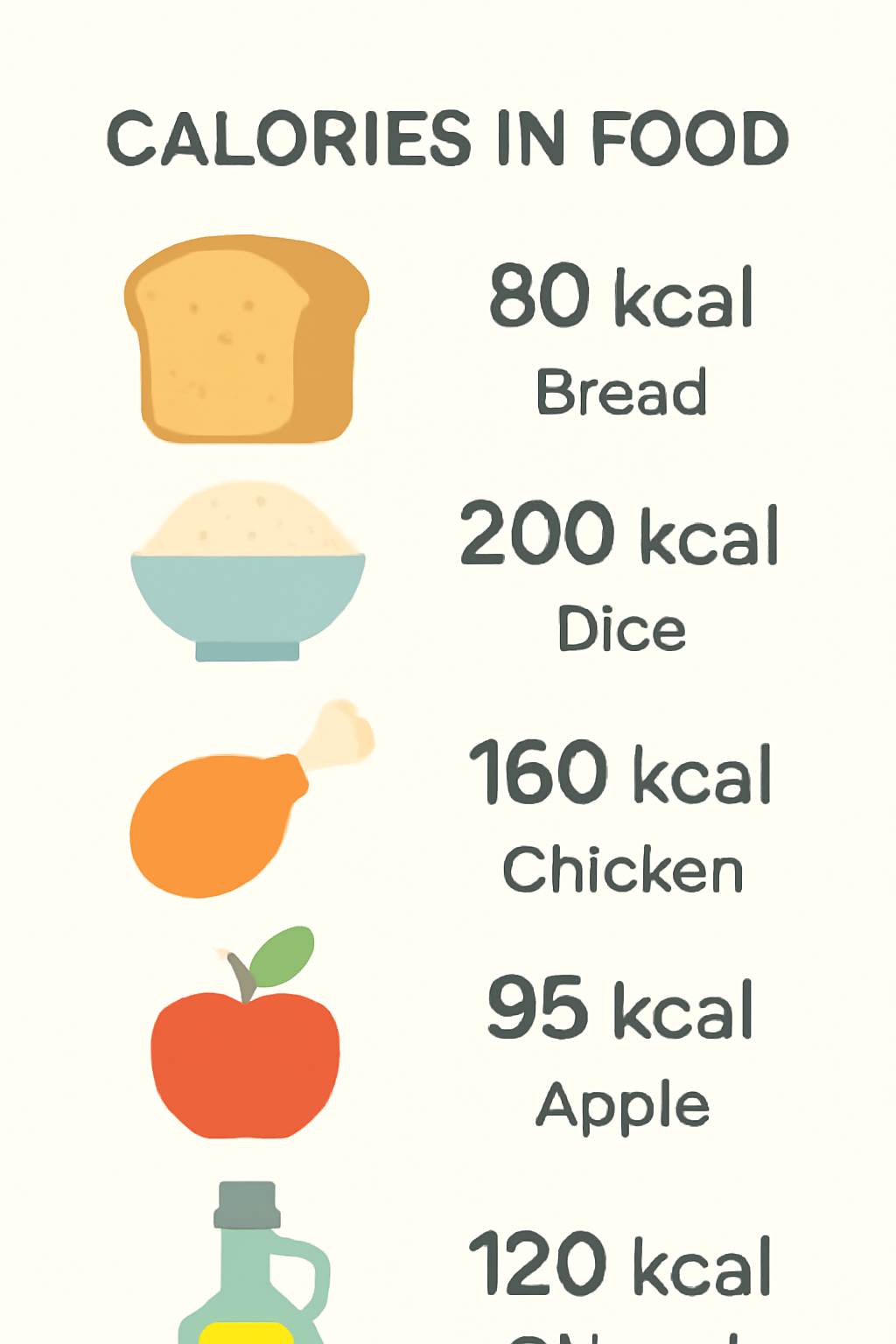Health & Fitness / Nutrition / By NutriFitCalc Team
Introduction
If you want to lose weight, gain weight, or simply maintain your current health, the first step is understanding how many calories you eat and burn every day. Many people believe that calculating calories requires professional tools, but that is not true. With a few basic methods and free online calculators, you can calculate calories at home with accuracy.
In this guide, we will explain how to calculate calories in food, recipes, and daily intake. We will also cover how to calculate calories for weight loss, weight gain, and calories burned during exercise. By the end, you will know how to manage calories confidently without depending on expensive nutritionists.

Calculate calories easily at home with simple tools
What Are Calories?
Calories are units of energy found in food and drinks. When we eat, the body converts calories into energy to fuel basic functions such as breathing, digestion, and movement. Extra calories that are not used get stored as fat.
Every food has calories, but the number varies depending on the type:
- 1 gram of carbohydrates = 4 calories
- 1 gram of protein = 4 calories
- 1 gram of fat = 9 calories
This explains why fatty foods are more calorie-dense. According to Harvard Health, managing calorie intake and expenditure is one of the most effective ways to control body weight.
Why Calculate Calories at Home?
Tracking calories is not just for athletes or dieters. It benefits everyone who wants to improve their health. Here is why you should learn to calculate calories at home:
- Weight control: Helps with weight loss, gain, or maintenance.
- Awareness: Many foods contain hidden calories.
- Health monitoring: Prevents obesity-related conditions.
- Cost-effective: No need to visit a nutritionist every time.
The NIH recommends calorie awareness as part of healthy weight management strategies.
Tools Needed to Calculate Calories at Home
You do not need complicated devices. These simple tools are enough:
- Kitchen scale: To weigh food portions.
- Measuring cups/spoons: For liquids and grains.
- Food labels: Most packaged foods list calories.
- Online calculators: Free tools like the Nutrifitcalc Calorie Calculator make the process simple.
How to Calculate Calories in Food
Every packaged food lists calories on the nutrition label. If food does not have a label, you can use databases such as the USDA Food Database.
Example:
- A slice of bread = 80 calories
- 1 tablespoon of peanut butter = 95 calories
- 1 teaspoon of jam = 50 calories
- Total: 225 calories for one peanut butter and jam sandwich.
This method allows you to know exactly how many calories are in each meal.
How to Calculate Calories in Recipes
When cooking at home, you can calculate the calories of a recipe by adding up the calories of each ingredient, then dividing by the number of servings.
Example: Homemade Pasta Dish
- 200 g pasta = 300 calories
- 100 g chicken breast = 165 calories
- 1 tablespoon olive oil = 120 calories
- Tomato sauce = 80 calories
- Total = 665 calories ÷ 2 servings = 332 calories per serving
This simple method helps in meal planning and portion control.
How to Calculate Calories Intake per Day
Your daily calorie needs depend on age, gender, height, weight, and activity level. The formula used is called the Basal Metabolic Rate (BMR), combined with an activity multiplier.
Daily Calories = BMR × Activity Factor
Activity Factors:
- Sedentary (little activity) = BMR × 1.2
- Lightly active = BMR × 1.375
- Moderately active = BMR × 1.55
- Very active = BMR × 1.725
Example for Male
- Age: 30 years, Weight: 75 kg, Height: 175 cm
- BMR ≈ 1700
- Activity: Moderate → 1700 × 1.55 = 2635 calories per day
Example for Female
- Age: 28 years, Weight: 60 kg, Height: 165 cm
- BMR ≈ 1400
- Activity: Light → 1400 × 1.375 = 1925 calories per day
You can save time using the Nutrifitcalc Calorie Calculator.

Calculate your daily calorie needs based on your activity level
How to Calculate Calories for Weight Loss or Gain
For Weight Loss
To lose weight, create a calorie deficit, which means eating fewer calories than you burn. A deficit of 500 calories per day leads to about 0.5 kg weight loss per week.
For Weight Gain
To gain weight, create a calorie surplus by eating more calories than you burn. Adding 300–500 calories per day is a healthy approach.
The Mayo Clinic suggests slow and steady changes for sustainable results.
How to Calculate Calories Burned
Calories burned include energy used for basic functions and physical activity. Exercise can significantly increase calorie expenditure.
Example Burn Rates (30 minutes):
- Walking = 120 calories
- Jogging = 250 calories
- Running = 400 calories
- Cycling = 300 calories
(Estimates based on CDC data).
Tracking calories burned helps balance intake and expenditure for better results.
How to Calculate Calories According to Weight
Calorie needs increase with body weight. Here is a simple guide for adults (average height, moderate activity):
| Weight (kg) | Calories Needed Per Day |
|---|---|
| 50 | ~1800 |
| 60 | ~2000 |
| 70 | ~2300 |
| 80 | ~2600 |
| 90 | ~2900 |
This table gives a quick reference, but individual needs may vary.
Tips for Accurate Calorie Tracking
- Weigh food instead of guessing.
- Log meals immediately after eating.
- Stay consistent with portion sizes.
- Use the same calculator for tracking.
- Review weekly instead of daily for long-term accuracy.
FAQs
Use food labels, a kitchen scale, and manual formulas.
Most people need a deficit of 500–750 calories per day.
Use activity-based estimates or fitness trackers.
Yes, but focus on balanced nutrition, not just numbers.
Yes, but consult pediatric guidelines, as children's needs vary.
Conclusion
Learning how to calculate calories at home is a valuable skill that helps with weight loss, weight gain, and maintaining health. By tracking calories in food, recipes, and daily intake, you gain control over your nutrition and lifestyle.
The easiest way is to use an online tool like the Nutrifitcalc Calorie Calculator, which simplifies the process and provides accurate results. With consistency, you can build healthy habits, avoid overeating, and reach your fitness goals.
Try Our Calorie CalculatorDisclaimer
The information provided in this blog post is for general informational purposes only. It is not intended as medical advice, diagnosis, or treatment. Please consult a healthcare professional before making any significant changes to your health or fitness routine. The accuracy of calorie calculations may vary based on individual factors.
About the Author
This article is written by the NutriFitCalc Team, a group of Food Science and Nutrition students who create simple, research-backed guides for healthy living.
We review global health sources like WHO and CDC to keep our content accurate and helpful.

I will immediately snatch your rss feed as I can’t to find your e-mail subscription link or e-newsletter service. Do you have any? Please permit me know in order that I may just subscribe. Thanks.